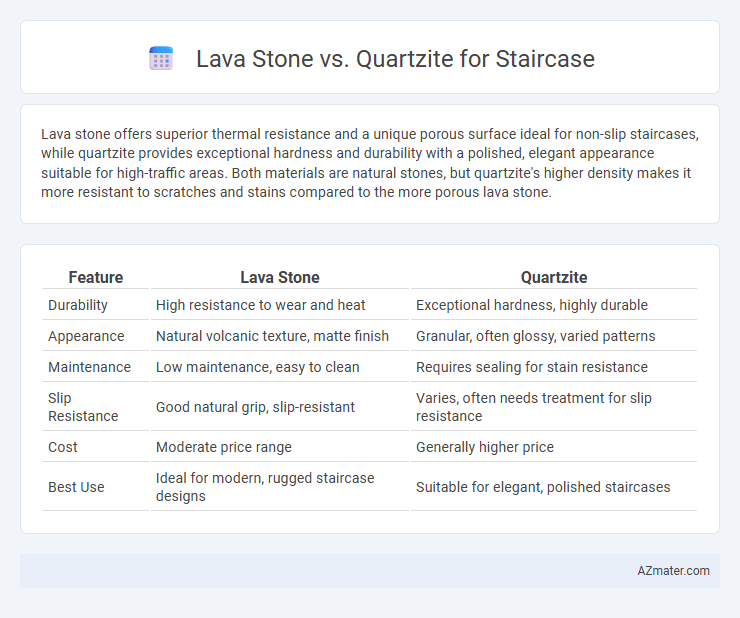Lava stone offers superior thermal resistance and a unique porous surface ideal for non-slip staircases, while quartzite provides exceptional hardness and durability with a polished, elegant appearance suitable for high-traffic areas. Both materials are natural stones, but quartzite's higher density makes it more resistant to scratches and stains compared to the more porous lava stone.
Table of Comparison
| Feature | Lava Stone | Quartzite |
|---|---|---|
| Durability | High resistance to wear and heat | Exceptional hardness, highly durable |
| Appearance | Natural volcanic texture, matte finish | Granular, often glossy, varied patterns |
| Maintenance | Low maintenance, easy to clean | Requires sealing for stain resistance |
| Slip Resistance | Good natural grip, slip-resistant | Varies, often needs treatment for slip resistance |
| Cost | Moderate price range | Generally higher price |
| Best Use | Ideal for modern, rugged staircase designs | Suitable for elegant, polished staircases |
Introduction: Comparing Lava Stone and Quartzite for Staircases
Lava stone offers exceptional durability and a unique porous texture ideal for staircases with high foot traffic, providing slip resistance and heat retention. Quartzite, a natural metamorphic rock, combines hardness with a sleek, polished finish that enhances staircase aesthetics while resisting scratches and stains. Both materials excel in strength but lava stone emphasizes rugged resilience, whereas quartzite prioritizes refined elegance for modern staircase designs.
Origin and Formation of Lava Stone vs Quartzite
Lava stone, formed from cooled molten lava typically originating from volcanic eruptions, features a porous texture and high heat resistance suitable for staircases exposed to temperature variations. Quartzite, a metamorphic rock derived from sandstone subjected to intense heat and pressure deep within the Earth's crust, offers exceptional hardness and durability due to its interlocking quartz crystals. The distinct geological origins influence their structural properties, making lava stone more suitable for heat resistance and quartzite optimal for abrasion resistance in staircase applications.
Physical Appearance and Aesthetic Appeal
Lava stone offers a unique matte texture with natural volcanic patterns that lend a rugged and earthy aesthetic to staircases, ideal for modern rustic designs. Quartzite features a smooth, glass-like finish with intricate veining and a wide color spectrum, providing a sophisticated and elegant look that complements both contemporary and classic interiors. The choice between the two materials depends on desired visual warmth and surface smoothness, with lava stone delivering a more tactile, organic appeal and quartzite presenting a polished, refined appearance.
Durability and Strength for Staircase Applications
Lava stone offers exceptional durability and heat resistance, making it ideal for high-traffic staircase applications where scratch and impact resistance are crucial. Quartzite boasts superior hardness and tensile strength compared to most natural stones, ensuring long-lasting performance and minimal wear in staircases. Both materials provide excellent structural integrity, but quartzite generally outperforms lava stone in strength, supporting heavier loads and extensive use.
Slip Resistance and Safety Features
Lava stone offers exceptional slip resistance due to its naturally rough, porous texture, making it a safe choice for staircases, especially in wet or high-traffic areas. Quartzite, while harder and more durable, tends to be smoother and may require additional anti-slip treatments to enhance safety on stair surfaces. Prioritizing slip resistance, lava stone provides superior traction, reducing the risk of slips and falls compared to untreated quartzite.
Maintenance Requirements and Longevity
Lava stone offers exceptional durability and low maintenance due to its dense, non-porous structure, requiring only occasional sealing to resist stains and moisture, making it ideal for high-traffic staircases. Quartzite staircases demand regular sealing and cleaning to prevent etching and staining, as this natural stone is more porous and sensitive to acidic substances. Both materials provide excellent longevity, but lava stone's superior resistance to wear and environmental factors often results in a longer-lasting, maintenance-friendly surface.
Cost Comparison: Lava Stone vs Quartzite
Lava stone typically costs between $20 to $40 per square foot, making it a more budget-friendly option for staircases compared to quartzite, which ranges from $50 to $100 per square foot due to its durability and aesthetic appeal. Installation expenses for quartzite can be higher because of its hardness, requiring specialized tools and labor, whereas lava stone's softer texture often results in lower labor costs. When considering long-term value, quartzite offers superior resistance to scratches and stains, potentially reducing maintenance costs over time despite the higher initial investment.
Installation Process and Practical Considerations
Lava stone offers a relatively straightforward installation process due to its lightweight nature and natural porous texture, requiring specialized sealants to prevent moisture absorption on staircases. Quartzite, known for its extreme hardness and density, demands professional handling with diamond-tipped tools and precise leveling to ensure durability and safety on stair treads. Practical considerations include lava stone's superior slip resistance ideal for wet environments, whereas quartzite provides exceptional scratch resistance and longevity but may require additional anti-slip treatments.
Environmental Impact and Sustainability
Lava stone offers a highly sustainable option for staircases due to its natural formation from volcanic activity, requiring minimal processing and resulting in a lower carbon footprint compared to Quartzite. Quartzite, while durable, often involves extensive quarrying and energy-intensive processing, increasing its environmental impact significantly. Choosing Lava stone can contribute to eco-friendly building practices by reducing resource depletion and promoting natural material use.
Which is Better: Lava Stone or Quartzite for Staircases?
Lava stone offers exceptional durability and heat resistance, making it ideal for high-traffic staircase applications, while quartzite provides superior hardness and a naturally elegant appearance with excellent scratch and stain resistance. Both materials are non-porous and low-maintenance, but quartzite tends to be slightly more expensive due to its rarity and aesthetic appeal. Choosing between lava stone and quartzite for staircases depends on balancing cost, desired texture, and long-term durability requirements.

Infographic: Lava stone vs Quartzite for Staircase
 azmater.com
azmater.com